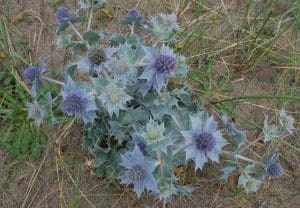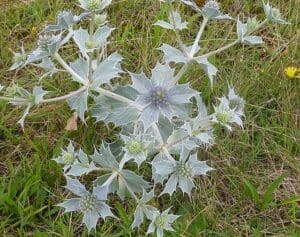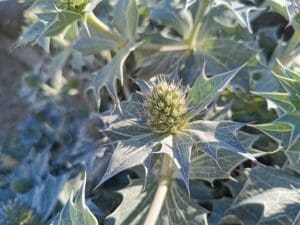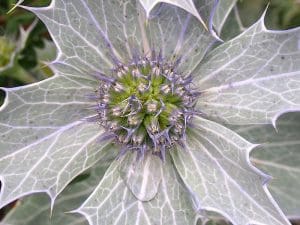Sea Holly / All Year Round / Edible
Sea Holly is one of those plants that from looking at it and touching it you wouldn’t imagine it was edible one bit, it has sharps spikes on it but once you get past them there are some tasty bits to enjoy.
Common Names
Sea Holly, sea eryngo, sea eryngium
Botanical Name
Eryngium maritimum
Scientific Classification
Kingdom – Plantae
Order –Apiales
Family – Apiaceae
Physical Characteristics for Sea Holly
Branched perennial 30 – 60cm high.
Leaves
The leaves waxy grey with thick margins, edged with long spines; root leaves long-stalked, palmate-veined, rounded; stem leaves are stalkless and tend to wrap around the stem.

Alan Fryer / Celyn y môr (Eryngium maritimum) Sea Holly
Stem
The stem is round and ribbed.

Flowers
The umbel of flowers is globular in form rather than flat, oval, 2.5 – 4.0cm long; umbels sit above a whorl of oblong, spiny bracts. The umbel is formed of bright, clear-blue, spine-like flowers (8mm wide) in close packed clumps of five flowers, each of which has a spine-like, three lobed bract. Fruit to 5mm long, oblong, covered with hooked bristles.

Habitat
Above the high tide mark of shingle and sandy shores; on sand dunes, up to 300m, found only on the coast.
Known Hazards
None known
Could be Confused with
There are a number of thistles with purple flowers, for example the Creeping Thistle (Cirsium arvense). Thistles are part of the daisy or Compositae family in which the flower is a dense head of florets on a disc surrounded by multiple layers of bracts, whereas the Sea Holly is an umbellifer which has numerous tiny flowers which radiate from a central point. The leaves of thistles are long and pinnate, often with stoutly spined edges whereas the Sea Holly leaves are about as long as they are wide, greyish-blue in colour, very stiff with spikes and thick white margins and veins.
Teasel (Dipsacus fullonum), but the form of the teasel is different in that the flower is a cluster of florets in a dense head. The stem of the flower is very long – up to 2m. In the second year a very prickly branched flower stem grows from the first-year rosette of leaves, with opposite leaves with few teeth and prickles only on the underside and midrib.
Edible Uses
First spring leaves are tender enough to eat, though the flavour is quite overpowering, similar to the roots. Use to infuse flavour into puddings or sauces.
Roots were previously used and have a similar flavour to the Indonesian spice Galangal and can be used in similar ways. Digging up whole roots is illegal and would have a negative impact very quickly. Digging up of roots to make candied treats called Eringos during the Elizabethan era may be responsible for the disappearance of this species in many parts of the British Isles.
Notes on Herbal uses
A sweet mucilaginous herb that is diuretic, anti-inflammatory and expectorant.
Extra notes from the Foragers
Sea Holly doesn’t support many insect herbivores as it is protected from grazing by its spininess, chemical defences and sclerophylly. However, Bees, Butterflies and other pollinators are unbothered by the sharp edges of the plant and seek out the Sea Holly for its nectar.
It is vulnerable to direct damage by trampling and is unable to withstand competition from faster and more densely growing plant species. In many coastal regions, in both temperate and Mediterranean parts of Europe, it is one of the rarest and most threatened plant species, mainly because of habitat loss and land-use changes.
In Greek poetry it has been recorded as a plant that will, if worn by a woman, make her husband or lover remain true to her.
In Elizabethan times, the flowers of Sea-holly were used as an aphrodisiac and were even mentioned by Shakespeare as such.
The Romany Gypsies would give Sea-Holly to their stud stallions to make them more virile; a viagra for horses!







Leave a Reply
You must be logged in to post a comment.